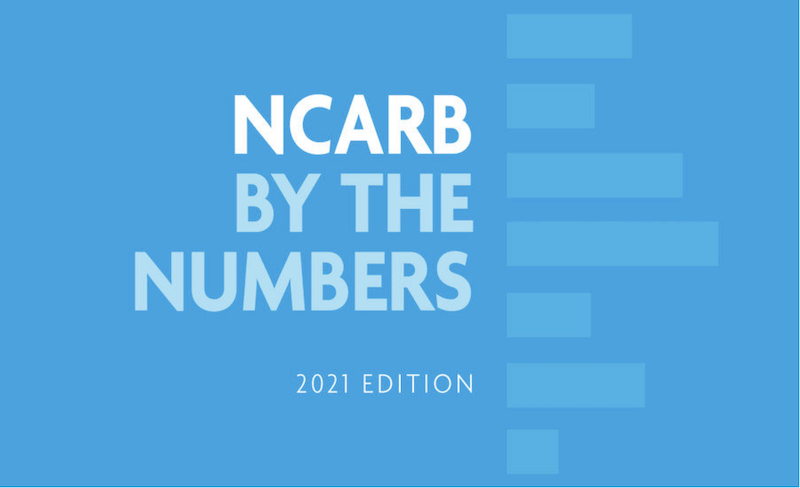On its 10th year of publishing information about its licensing exams, the National Council of Architectural Registration Boards (NCARB) for the first time has released a new section in the 2021 edition of its Architect Registration Examination that breaks down the pass rate by several demographic categories.
The six-part exam is required by all 55 NCARB jurisdictions in the U.S. for candidates seeking architectural licensure. More than 32,700 people took the test, and here are some of the key findings:
•White candidates’ pass rate is higher than that of candidates of color. The disparity is most pronounced in the Programming & Analysis division of the test that focuses on evaluating a project’s requirements and constraints; white candidates’ pass rate was 38 percentage points higher than their Black peers’.
•Men, in general, outperform women candidates on five of the exam’s six divisions. When factoring in race and ethnicity, Black women fare better on the test than Black male candidates.
•Candidates ages 18-29 have the highest pass rates across all six divisions. Candidates 40 years or older have the lowest rate.
Alfred Vidaurri Jr., FAIA, NCARB, AICP, who was inducted as NCARB’s president in June, stated that the findings were both unsurprising and unacceptable. “I challenge us to do better” he said of the industry, adding that he would concentrate on addressing these disparities during his tenure leading the organization.
The hardest part is getting some candidate groups to the finish line. NCARB reports that 63% of all candidates stay on their paths to licensure over 10 years, but that drops off to 61% for women candidates, 58% for Asian candidates, 57% for Hispanics, and 46% for Blacks.
NCARB WILL OFFER FREE PRACTICE TESTS

The report cites disparities in the rate of candidates pursuing licensure.
After commissioning an independent bias study of its exam, NCARB concluded that individual questions don’t drive disparities in candidates’ performance, and that the organization alone can’t resolve inequity in exam access and performance. “Coupled with NCARB’s data on career attrition, these studies suggest that pass rate disparities could also be impacted by access to education and professional experiences,” the organization stated.
Nevertheless, NCARB’s teams have been working to understand the causation of testing disparities, and the organization has pledged to launch the following changes, resources, and opportunities for feedback:
•For the first time in NCARB history, exam candidates have been appointed to the 2021 Examination Committee, which is responsible for recommending format and policy changes to NCARB’s national Board of Directors.
•NCARB is developing free practice tests for all six divisions, with a goal of offering the new suite of resources in mid-2022. (According to NCARB and the National Organization of Minority Architects’ joint Baseline on Belonging study, nearly half of respondents spent more than $500 on test prep materials.)
•NCARB is currently conducting another external audit of its exam, this time focused on the content areas to identify potential trends related to disparate pass rates.
•In addition to NCARB’s annual Think Tanks for emerging professionals and the upcoming Analysis of Practice study, the organization will launch two outreach initiatives in 2021-2022: licensure candidate focus groups conducted by an external consultant; and an Architecture Licensing Feedback survey, where the architect community can share their experience and recommendations.
•In 2019, NCARB launched an internal work group and commissioned external consultants to study licensure programs through an Equality, Diversity, and Inclusion lens. This effort is currently exploring potential links between exam performance and the criteria driving candidates’ Architectural Experience Program® (AXP®) reports, as well as firm culture.
The organization intends to release more details about these initiatives in the coming months.
Related Stories
| Apr 5, 2011
Are architects falling behind on BIM?
A study by the National Building Specification arm of RIBA Enterprises showed that 43% of architects and others in the industry had still not heard of BIM, let alone started using it. It also found that of the 13% of respondents who were using BIM only a third thought they would be using it for most of their projects in a year’s time.
| Apr 5, 2011
Top 10 Buildings: Women in Architecture
Making selections of top buildings this week led to a surprising discovery about the representation of women in architecture, writes Tom Mallory, COO and co-founder, OpenBuildings.com. He discovered that finding female-created architecture, when excluding husband/wife teams, is extremely difficult and often the only work he came across was akin to interior design.
| Apr 5, 2011
What do Chengdu, Lagos, and Chicago have in common?
They’re all “world middleweight cities” that are likely to become regional megacities (10 million people) by 2025—along with Dongguan, Guangzhou, Hangzhou, Shenzhen, Tianjin, and Wuhan (China); Kinshasa (Democratic Republic of the Congo); Jakarta (Indonesia); Lahore (Pakistan); and Chennai (India), according to a new report from McKinsey Global Institute: “Urban World: Mapping the economic power of cities”.
| Mar 30, 2011
China's low-carbon future city
In 2005, the Chinese government announced its target to reduce energy consumption per GDP unit by 20% by the year 2010. After a multi-billion investment, that target has been reached. The Chinese Climate Protection Program’s goal to increase energy efficiency, develop renewable energies, and promote energy savings while reducing pollutant emissions and strengthening environmental protection is reflected in the “Future City” by SBA Design.









